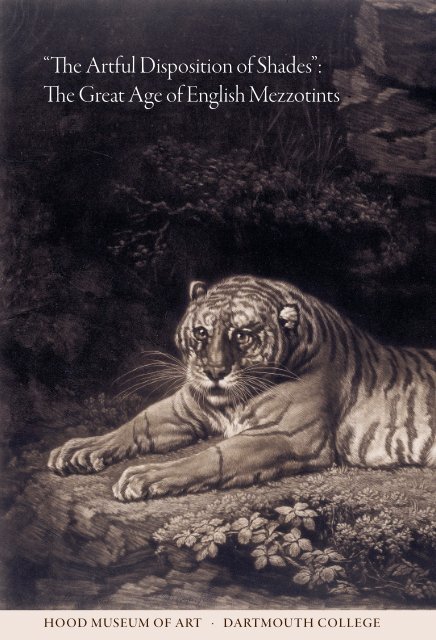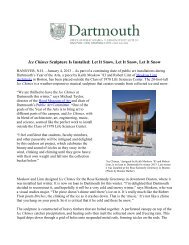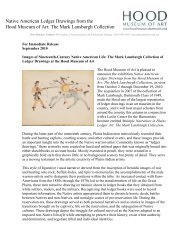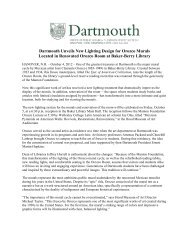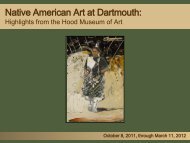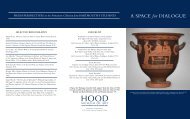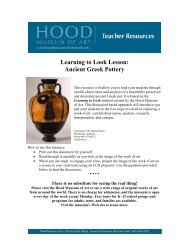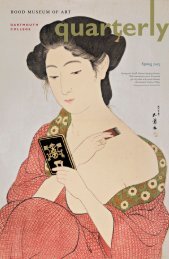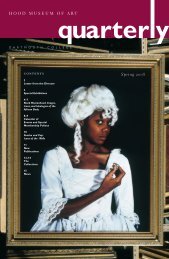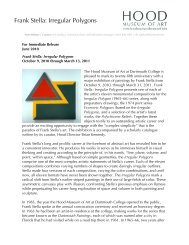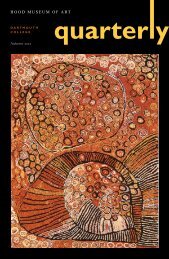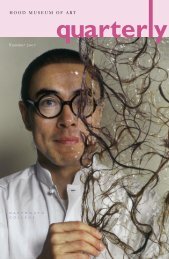The Great Age of English Mezzotints - Hood Museum of Art
The Great Age of English Mezzotints - Hood Museum of Art
The Great Age of English Mezzotints - Hood Museum of Art
- No tags were found...
You also want an ePaper? Increase the reach of your titles
YUMPU automatically turns print PDFs into web optimized ePapers that Google loves.
“<strong>The</strong> <strong>Art</strong>ful Disposition <strong>of</strong> Shades”:<strong>The</strong> <strong>Great</strong> <strong>Age</strong> <strong>of</strong> <strong>English</strong> <strong>Mezzotints</strong>hood museum <strong>of</strong> ar .1darmouh college
INTRODUCTIONSamson Occom’s (1723–1792) fundraising trip to England, Ireland, and Scotland from1766 to 1768 relied heavily on the power <strong>of</strong> the press to promote his mission. Newspapersreported on his sermons and travels, a published brochure described the goals <strong>of</strong>the campaign, and a printed portrait highlighted his celebrity (fig. 1). <strong>The</strong> image portrayedthe sitter’s erudition and exoticism in the most popular medium available atthat time: mezzotint. It was also one <strong>of</strong> the earliest prints to be collected at Dartmouth College.Immediately after Occom arrived in London along with Nathaniel Whitaker (1732–1795)in early 1766 to raise money “to support the Rev. Mr. Wheelock’s school at Lebanon in NewEngland” (London Evening Post, 1 May 1766, p. 1), they published a sixty-four-page bookletentitled A Brief Narrative <strong>of</strong> the Indian Charity School. It outlined their goal <strong>of</strong> “building andendowing an Indian academy for clothing, boarding, maintaining, and educating such Indiansas are designed for missionaries and schoolmasters, and for maintaining those who are, or hereaftershall be, employed on this glorious errand.” It also included numerous testimonials fromleading American ministers and statesmen. A second edition with new letters <strong>of</strong> recommendationcame out the following year. Copies were widely circulated in the British Isles during thetravelers’ two-year venture in order to publicize their background and objectives. Moreover, thecenterpiece <strong>of</strong> the promotional drive was the “Reverend Mr. Occom, the first pupil and IndianChristian which Mr. Wheelock educated, and the first Indian Preacher that ever set foot inBritain” (London Evening Post, 26 May 1767, p. 1). His orations were attended by “crowdedaudiences” and his movements prominently reported, quickly making him famous.Not surprisingly, the portrait <strong>of</strong> Occom painted by Mason Chamberlin (1727–1787)while the sitter was traveling overseas—likely commissioned by the Second Earl <strong>of</strong> Dartmouth(1731–1801)—was eventually translated into a print for mass distribution. <strong>The</strong> seated NativeAmerican preacher, depicted in clerical garments, appears serene and dignified. His gesturetoward the open Bible with handwritten notes in the margins emphasizes his education andChristian conversion. Yet, while the pose and setting reflect conventional images <strong>of</strong> the period,Occom’s complexion and hairstyle, and the bow and arrows hanging on the wall, emphasize hisforeignness. <strong>The</strong>se visual clues are reinforced by the inscription below, which again points to hisreputation as “the first Indian Minister that ever was in Europe.”<strong>The</strong> printed effigy was produced in response to the growing demand in England for affordableand accessible images <strong>of</strong> celebrated figures, and mezzotints were the preferred medium inthis regard. <strong>The</strong>se types <strong>of</strong> prints were especially valued by artists and collectors for their abilityto reproduce the painterly qualities <strong>of</strong> flesh, hair, and drapery. “Engraving and etching must getover the prejudices <strong>of</strong> cross lines, which exist on no natural bodies; but metzotinto [sic] gives usthe strongest representation <strong>of</strong> a surface” (Gilpin, An Essay on Prints, 1768, p. 60). Long afterthe original painting was lost and Occom had died, impressions <strong>of</strong> the print continued to becirculated and were used as the basis for newly engraved, lithographed, photographed, and evenpainted versions made well into the nineteenth century in England and the United States. Hisrefined portrait was issued in the midst <strong>of</strong> the great age <strong>of</strong> mezzotints. <strong>The</strong> era’s history and2
fig. 1. Jonathan Spilsbury after Mason Chamberlin, <strong>The</strong> Reverend Mr. SamsonOccom, 1768, mezzotint. Gift <strong>of</strong> Mrs. Robert W. Birch; pr.961.307.some <strong>of</strong> its supreme achievements are briefly described in the following pages and through anumber <strong>of</strong> representative examples in the accompanying exhibition.While copies <strong>of</strong> this print were some <strong>of</strong> the first to be found at Dartmouth College, manyothers that express fully the power <strong>of</strong> the medium have been added to the collection over thecourse <strong>of</strong> the last 241 years. Individual donors are acknowledged in the credit lines in the checklistat the back <strong>of</strong> this brochure. An additional seventeen superb mezzotints have been generouslylent by Robert Dance, Class <strong>of</strong> 1977, and Robert Loper, to whom the staff <strong>of</strong> the <strong>Hood</strong><strong>Museum</strong> <strong>of</strong> <strong>Art</strong> extends its deepest appreciation.—T. Barton Thurber3
fig. 2. James Watson after Anthony van Dyck, Paulus Pontius, about 1764, mezzotint. Purchasedthrough the Guernsey Center Moore 1904 Memorial Fund; pr.987.69.4
Production, Distribution & Marketing<strong>of</strong> <strong>English</strong> <strong>Mezzotints</strong> in the Eighteenth Centuryt. barton thurber, curator <strong>of</strong> european artIn the century before the advent <strong>of</strong> lithographic and photomechanical reproductions inthe early 1800s, mezzotints were favored for publicizing <strong>English</strong> paintings. Comparedto traditional printmaking techniques, such as engraving and etching, this later tonalmethod was better able to represent the painterly qualities <strong>of</strong> light and shadow. Althoughgenerations <strong>of</strong> artists had used prints to promote their designs, the establishment <strong>of</strong>regular public exhibitions in London in the second half <strong>of</strong> the eighteenth century significantlyincreased popular demand for inexpensive and widely available editions <strong>of</strong> fashionable pictures.<strong>Art</strong>ists and collectors were equally attracted to the dramatic appearance <strong>of</strong> mezzotints.One particular example highlighted the appeal <strong>of</strong> the medium. Soon after Anthony VanDyck’s (1599–1641) painting <strong>of</strong> Paulus Pontius (fig. 3) arrived in England following its purchasein Amsterdam in 1763, the portrait was rendered into a magnificent mezzotint (fig. 2). It wasone <strong>of</strong> the first prints that James Watson (1739/40–1790) had independently published soonafter moving to London from his native Ireland to work for and train with his fellow countrymanand printmaker James McArdell (about1729–1765). Watson, whose prints were characterizedby a high degree <strong>of</strong> finish, quicklyestablished a reputation as a well-regarded andtalented artist. His mezzotint after Van Dyck’spainting was an extraordinary display <strong>of</strong> thequalities <strong>of</strong> a technique that had “introduced as<strong>of</strong>tness and delicacy before unknown inprints” (Chelsum, A History, 1786, p. 4). It alsounderscored the differences between the mezzotintand other reproductive techniques,especially since the composition had alreadybeen etched by Van Dyck himself after thesame picture in about 1630—seen in reversedue to the printmaking process (fig. 4). <strong>The</strong>primary distinction between the two methodswas summarized by William Gilpin(1724–1804), who wrote in his An Essay onPrints <strong>of</strong> 1768, “In etching . . . you make theshades; in metzotinto the lights” (p. 57).<strong>The</strong> traditional intaglio printmaking methodssuch as etching and engraving, in whichthe ink is deposited into the recessions <strong>of</strong> ametal plate, employ a system <strong>of</strong> lines to indicatetonal transitions from light to dark. In the caseFig. 3. Anthony van Dyck, Paulus Pontius, about1630, oil on canvas, 35⅞ x 25¾ in. Jerusalem, Israel<strong>Museum</strong>.5
<strong>of</strong> Van Dyck’s etched portrait, the background wasfilled with a network <strong>of</strong> thin, intersecting lines,which contrasted with a pattern <strong>of</strong> hatching anddots to delineate the features <strong>of</strong> the figure. <strong>The</strong>effects <strong>of</strong> light and shade were rendered by varyingthe density <strong>of</strong> the markings, similar to the process<strong>of</strong> drawing with a pen. However, while VanDyck succeeded in conveying the character <strong>of</strong> thesitter (part <strong>of</strong> an ambitious printmaking project tocreate a uniform series <strong>of</strong> famous contemporariesderived from his portraits), the print failed to convincinglyreproduce the atmosphere and darkness<strong>of</strong> the painting. Nearly a century and a half later,Watson recognized the potential <strong>of</strong> mezzotint tobetter capture the complete tonality and drama <strong>of</strong>Van Dyck’s picture. He started with a copper plate,the entire surface <strong>of</strong> which had already beenabraded with a tiny mesh <strong>of</strong> indentations by a serratedtool called a rocker. If printed at that stage,the dots in the plate would have deposited an even,velvety layer <strong>of</strong> ink on the paper. <strong>The</strong> next step infig. 4. Anthony van Dyck, Paulus Ponitus, the process required the burnishing, or smoothingabout 1630; reprinted in the second half <strong>of</strong>out, <strong>of</strong> the areas intended to appear gradated orthe 17th century, etching and engraving.white, removing the indentations so that little orPurchased through the Adelbert Ames Jr.1919 Fund; 2009.62no ink would be transferred to the paper. <strong>The</strong>shaded sections were left alone. Watson’s portraitprint demonstrated the affinity <strong>of</strong> the mezzotintmethod to painting in black and white, which differentiated it from other forms <strong>of</strong> printmakingin its ability to replicate the subtle areas <strong>of</strong> shadow and dark colors in Van Dyck’s original.First invented in Germany in the mid-seventeenth century, the tonal rather than the linearprocess was especially favored by <strong>English</strong> painters, who praised its “expression <strong>of</strong> flesh morenaturally, or the flowing <strong>of</strong> hair, or the folds <strong>of</strong> drapery, or the catching lights <strong>of</strong> armour” (Gilpin,An Essay on Prints, 1768, p. 60). As a result, mezzotint was adapted chiefly to portraiture or historysubjects with a few figures. Given the growing popularity <strong>of</strong> portrait painting and the wellestablishedtradition <strong>of</strong> collecting portrait prints in Britain, the medium soon became knownon the Continent in the eighteenth century as la manière anglaise, or “the <strong>English</strong> manner”(Heinecken, Idée générale . . . d’estampes, 1771, p. 208).One particular advantage <strong>of</strong> the mezzotint technique over line engraving was its facilityand quickness in the hands <strong>of</strong> an expert, which made it cheaper to produce excellent copiesafter a variety <strong>of</strong> distinguished pictures. Yet, due to the fragility <strong>of</strong> the raised surface <strong>of</strong> the plate,which would flatten after repeated printings, only a limited number <strong>of</strong> strong impressions couldbe made—sometimes no more than one hundred. In order to distinguish good, early impressionsfrom later copies, publishers increasingly issued different versions <strong>of</strong> a print, called states,such as those before the addition <strong>of</strong> inscriptions or with the letters barely scratched into thesurface <strong>of</strong> the plate. <strong>The</strong>se so-called pro<strong>of</strong>s, presumably produced in small quantities before the6
fig. 5. John Smith after Sir Godfrey Kneller, SirGodfrey Kneller, 1694, mezzotint. Collection <strong>of</strong>Robert Dance, Class <strong>of</strong> 1977.fig. 6. John Smith after Godfrey Kneller, JohnSmith, 1716, mezzotint. Collection <strong>of</strong> RobertDance, Class <strong>of</strong> 1977.ordinary edition, were intended as a guarantee to buyers <strong>of</strong> better quality, and were, therefore,more expensive.One <strong>of</strong> the first native-born practitioners to popularize mezzotints in England was JohnSmith (1652–1743), whose reputation was linked with that <strong>of</strong> the leading portrait painter <strong>of</strong> theera, Sir Godfrey Kneller (1646–1723). Although there is no surviving evidence to indicate thatKneller benefitted financially from the production <strong>of</strong> mezzotints after his canvases, it wasundoubtedly advantageous for the painter to publicize his work in order to obtain new commissions.It was equally important for the print publisher to maintain a constant supply <strong>of</strong>paintings to reproduce. <strong>The</strong> alliance enhanced both Kneller’s and Smith’s careers, due especiallyto the increased demand for painted and printed portrayals <strong>of</strong> family members, ancestors, andother notable individuals following the restoration <strong>of</strong> the monarchy in the second half <strong>of</strong> theseventeenth century. Between 1689 and 1721, Smith translated a total <strong>of</strong> 140 pictures by Kneller.As a sign <strong>of</strong> their close relationship, the printmaker produced an elegant mezzotint <strong>of</strong> thepainter’s self-portrait in 1694 (fig. 5), which was reciprocated two years later by a depiction <strong>of</strong>Smith holding a copy <strong>of</strong> Kneller’s paper effigy, eventually printed in 1716 (fig. 6).Like all young mezzotint artists, Smith initially worked for other printmakers and printsellers,receiving a fixed fee for each plate he executed. He soon realized, however, that in orderto obtain a share <strong>of</strong> the pr<strong>of</strong>its, he would have to become involved in all aspects <strong>of</strong> the business.Ultimately, after being employed by others for the first ten years <strong>of</strong> his career, from 16937
onward he controlled both the production anddistribution <strong>of</strong> his own prints (Griffiths, “EarlyMezzotint Publishing in England,” p. 251).One way to defer the expense <strong>of</strong> independentlypreparing and issuing prints was to advertisethe future availability <strong>of</strong> particular designsthrough a subscription process, which guaranteedcollectors “the best impressions.” ThomasFrye (1710–1762), an Irish-born painter whotraveled to London in the 1730s and set himselfup as a portrait specialist, used this process tosell “Twelve Mezzotinto Prints . . . drawn fromNature and as large as life” (<strong>The</strong> Public Advertiser,28 April 1760, p. 4). <strong>The</strong> result was a novelseries <strong>of</strong> varied character studies not based onpreexisting paintings and unidentified except fora single self-portrait (fig. 7). <strong>The</strong> striking poses,and Frye’s successful use <strong>of</strong> the dramatic lighteffects that mezzotint could supply, made animmediate impact. One critic praised them in<strong>The</strong> British Magazine in June 1760 (vol. 1, no. 5,p. 135), and Joseph Wright <strong>of</strong> Derby (1734–1797)fig. 7. Thomas Frye, Ipse (Self-Portrait), 1760, included one <strong>of</strong> the heads—the seated youngmezzotint. Purchased through a gift from theman on the far left—in his painting ExperimentCremer Foundation in memory <strong>of</strong> J. <strong>The</strong>odoreCremer; 2006.53.on the Air Pump <strong>of</strong> 1768, which was released as amezzotint the following year (see fig. 9).Awareness <strong>of</strong> Frye’s figures was facilitated bytheir display in 1760 in the first exhibition <strong>of</strong> the Society <strong>of</strong> <strong>Art</strong>ists, in which the series waspresented alongside objects by sixty-seven other painters, sculptors, architects, and designers.From the beginning <strong>of</strong> the newly established event, mezzotint printmakers realized the importance<strong>of</strong> public exhibitions in attracting popular and critical attention. Painters, too, found theshows helpful for promoting themselves and their pictures to a broad audience, especially whenprints after their compositions appeared in the same year or soon afterward. For Joseph Wright<strong>of</strong> Derby, who had already established a reputation as a regional portraitist by the mid-1750s,fourteen <strong>of</strong> the paintings that he exhibited in London between 1765 and 1772 were printed—twelve <strong>of</strong> them as mezzotints. <strong>The</strong> prints served as a lasting record <strong>of</strong> the artist’s most notableexamples <strong>of</strong> his early “candlelight pictures,” which were characterized by spectacular effects <strong>of</strong>natural and artificial light. Most <strong>of</strong> these images were not individual portraits but rather large,multi-figure interior scenes, generally produced on speculation for sale to the general public. Inmany instances the prints were issued within six months after the paintings had been exhibitedand <strong>of</strong>ten praised by critics. In one case, Richard Earlom’s (1743–1822) A Blacksmith’s Shop <strong>of</strong>1771 (fig. 8), the print appeared on the market less than three months after the closing <strong>of</strong> theexhibition in which the painting was displayed. <strong>The</strong> inscription pointed out that the originalhad already been purchased by an eminent patron. Such publicity enhanced the prestige <strong>of</strong>painters, but it also advanced the careers <strong>of</strong> printmakers.8
fig. 8. Richard Earlom after Joseph Wright <strong>of</strong> Derby, A Blacksmith’s Shop, 1771, mezzotint.Purchased through the Julia L. Whittier Fund; pr.952.66.9
fig. 9. Valentine Green after Joseph Wright <strong>of</strong> Derby, Experiment on the Air Pump, 1769,mezzotint. Purchased through gifts from the Lathrop Fellows; 2008.10.Several <strong>of</strong> the earliest mezzotint versions <strong>of</strong> Wright’s works were themselves exhibited,including Valentine Green’s (1739–1813) Experiment on the Air Pump, published on his own in1769 as his grandest and most complex print to date (fig. 9). <strong>The</strong> printmaker faithfully renderedthe depiction <strong>of</strong> a variety <strong>of</strong> poses and facial expressions, heightening the nighttime drama <strong>of</strong> afamily observing a traveling lecturer as he demonstrates the potentially lethal effects <strong>of</strong> his pneumaticdevices. <strong>The</strong> image’s quality, delicacy, and precision soon attracted the attention <strong>of</strong> thepublisher John Boydell (1719–1804), who purchased the plate immediately after the exhibition<strong>of</strong> Green’s mezzotint and reissued it in late June <strong>of</strong> the same year.From the 1760s onward in London, the annual exhibitions <strong>of</strong> the Society <strong>of</strong> <strong>Art</strong>ists, theRoyal Academy, and other organizations drew large numbers <strong>of</strong> visitors and critics. <strong>The</strong> <strong>English</strong>writer and connoisseur Horace Walpole (1717–1797) complained in 1770 that “the rage to seethese exhibitions is so great that sometimes one cannot pass through the streets.” He immediatelyadded that “another rage is for prints,” with the consequence that prices for mezzotints inparticular—“which I have been collecting for thirty years”—had recently increased by as muchas 500 percent (Correspondence, vol. 7, p. 211). In addition to these major events, regular displayscould be found at print shops around the city. In one humorous composition <strong>of</strong> 1773, Miss Macaroniand Her Gallant at a Print Shop (fig. 10), John Raphael Smith (1751–1812) represented10
fig. 10. John Raphael Smith, Miss Macaroni and Her Gallant at a Print Shop, 1773, mezzotint.Purchased through the Adelbert Ames Jr. 1919 Fund; 2007.39.2.11
fig. 11. Richard Earlom after Jan van Huysum, A Flower Piece, 1778, mezzotint, etching, and stippleengraving. Purchased through the Florence and Lansing Porter Moore 1937 Fund; 2009.41.12
four people in front <strong>of</strong> the window <strong>of</strong> John Bowles’s (about 1717–1779) salesroom in London’shistoric center. A prostitute, her client, and two other male bystanders were shown observingand discussing the array <strong>of</strong> mezzotints <strong>of</strong> well-known reformed clergymen at the top and thesatires below—many <strong>of</strong> which have recently been identified. <strong>The</strong> spectacle revealed the allure <strong>of</strong>prints for consumers <strong>of</strong> all classes, who were continuously attracted by novel subjects.<strong>The</strong> largest print shop in the city in the second half <strong>of</strong> the eighteenth century was owned byJohn Boydell, who began as an engraver and eventually rose to prominence as an entrepreneuremploying artists on a variety <strong>of</strong> large-scale publishing projects. While his business in the 1750sand 1760s was predominantly based on importing foreign prints, Boydell’s catalogue <strong>of</strong> 1769reflects a shift toward reproductive printmaking aimed at capitalizing on the growing <strong>English</strong>trade. Over the course <strong>of</strong> the next three-and-a-half decades, he produced a number <strong>of</strong> large setsand individual prints that drew attention to prominent artists, works, and collections. One <strong>of</strong>his most ambitious endeavors was the translation <strong>of</strong> 162 paintings that had once belonged to SirRobert Walpole, later First Earl <strong>of</strong> Orford (1676–1745), at Houghton Hall, Norfolk, which werefig. 12. Richard Earlom after Claude Lorrain, Pastoral Landscapefrom the series Liber Veritatis,1774, mezzotint and etching. Gift <strong>of</strong> Mr. and Mrs. Adolph Weil Jr., Class <strong>of</strong> 1935; mis.989.26A [7].13
later acquired by Catherine the <strong>Great</strong>(1729–1796) for the newly built Hermitagein Saint Petersburg. <strong>The</strong> HoughtonGallery prints were issued generally in sets<strong>of</strong> ten between 1774 and 1788—nearlyhalf <strong>of</strong> them executed as mezzotints.<strong>The</strong> leading printmaker among the fortyfiveinvolved in the vast enterprise wasRichard Earlom, who prepared twenty-sixplates, including the extraordinary pairA Fruit Piece and A Flower Piece (fig.11) after the Dutch painter Jan van Huysum(1682–1749). Earlom perfected themixed-media technique that combinedmezzotint and etching to render a richvariety <strong>of</strong> textures and hues. He used thesame method to reproduce the subtlevariations <strong>of</strong> tone in his reproduction <strong>of</strong>two hundred pen-and-wash drawings byClaude Lorrain (1600–1682), which thepainter had bound together and entitledthe Liber Veritatis, or “Book <strong>of</strong> Truth,” asa partial record <strong>of</strong> his pictures (fig. 12).Boydell’s advertisement for the first <strong>of</strong> thetwo volumes <strong>of</strong> prints emphasized Earlom’sability to replicate “the manner andfig. 13. Henry Birche (pseudonym for Richard Earlom)taste <strong>of</strong> the original drawings” (<strong>The</strong> Publicafter Thomas Gainsborough, Boys and Dogs, 1791, mezzotintand etching. Collection <strong>of</strong> Robert Loper.Advertiser, 12 April 1774, p. 1).Although no concrete evidence hasbeen found to indicate that Earlom wascontractually restricted from working for any other publishers from 1781 to 1793, he apparentlyprepared several plates for Benjamin Beale Evans (about 1765–1824) under the pseudonym <strong>of</strong>Henry Birche in the 1790s. In the case <strong>of</strong> Boys and Dogs <strong>of</strong> 1791 (fig. 13), the printmaker capturedthe haunting atmosphere <strong>of</strong> bucolic tranquility and striking violence in Thomas Gainsborough’s(1727–1788) celebrated canvas. Earlom and Evans subsequently collaborated oneleven other mezzotints between 1793 and 1799, almost all <strong>of</strong> which reproduced <strong>English</strong> painters(Rubenstein, “Richard Earlom,” p. 21).<strong>The</strong> various annual exhibitions raised public awareness <strong>of</strong> contemporary artists in Englandand likewise increased demand for prints <strong>of</strong> more fashionable pictures instead <strong>of</strong> those by foreignersand old masters. Given the prevalence <strong>of</strong> portraits at many <strong>of</strong> these events, there was acorresponding interest in such subjects, especially those <strong>of</strong> Sir Joshua Reynolds (1723–1792),the most influential painter <strong>of</strong> his day and the first president <strong>of</strong> the Royal Academy. From themid-1750s onward, Reynolds recognized the power <strong>of</strong> the prints to promote his pictures. Asone critic noted in 1787, “Sir Joshua has been more indebted to [printmaking] than any otherartist past or present. <strong>The</strong> preservation <strong>of</strong> such designs as his is an act <strong>of</strong> service to fame” (British14
fig. 14. John Jones after Sir Joshua Reynolds, Mrs. Tollemache in the Character <strong>of</strong> Miranda, 1786,mezzotint. Collection <strong>of</strong> Robert Dance, Class <strong>of</strong> 1977.15
Mercury vol. 3, p. 321, cited in Clayton, “‘Figures <strong>of</strong> Fame,’” p. 59, n. 4). In the last four decades<strong>of</strong> the artist’s life, over four hundred authorized prints were issued after Reynolds’s paintings—generally those that had been exhibited publicly at the Royal Academy. <strong>The</strong> vast majority <strong>of</strong>these were mezzotints, a method that was closely associated with his predilection for the strikingeffects <strong>of</strong> light and shadow. One scholar suggested that in some instances the painter mayhave partially modified his style so that it could be better reproduced in this manner (Godfrey,Printmaking in Britain, p. 48).In the case <strong>of</strong> the portrayal <strong>of</strong> Mrs. Tollemache, the Countess <strong>of</strong> Dysart (1745–1804; fig.14), the original painting was exhibited at the Royal Academy in 1774 with only the title ALady in the Character <strong>of</strong> Miranda in the Tempest. Like many <strong>of</strong> Reynolds’s “Grand Manner”pictures aimed at elevating portraiture to the status <strong>of</strong> history painting, it depicted a beautifularistocratic woman in the guise <strong>of</strong> the heroine in the play by Shakespeare (1564–1616). She wassurrounded by characters and scenes described in the text, including Caliban, the monster; Prospero,her father (behind the tree); and the wrecked ship carrying her future spouse, Ferdinand(in the background). While one observer chastised the painter for including too many details(<strong>The</strong> Public Advertiser, 3 May 1774, p. 2), a later critic praised the printmaker, John Jones (about1745–1797), for fully depicting “the youthful graces <strong>of</strong> Mrs. Tollemache” (<strong>The</strong> Public Advertiser,27 April 1786, p. 3) in the print, one <strong>of</strong> twenty-five that he rendered after Reynolds’s portraits.Another artist whose reputation was greatly enhanced through the publication <strong>of</strong> his compositionswas George Stubbs (1724–1806), a renowned <strong>English</strong> painter <strong>of</strong> domestic and exoticanimals, as well as other subjects. During his lifetime, there were 218 prints made after his picturesand compositions, including eighteen engravings and mezzotints prepared by Stubbs himself.It remains unclear to what extent the painter was directly involved in the production anddistribution <strong>of</strong> many <strong>of</strong> these prints; however, with regard to the more elaborate ones intendedfor elite collectors, Stubbs <strong>of</strong>ten supervised the entire process. One particular example was ATigress (cover and fig. 15), based on a painting exhibited to grand acclaim at the Society <strong>of</strong><strong>Art</strong>ists’ exhibition in 1769. It represented a tiger given in 1762 to George Spencer, fourth Duke<strong>of</strong> Marlborough (1738/39–1817), by Lord Clive, Governor <strong>of</strong> Bengal (1725–1774). John Dixon(about 1740–1811), an Irish engraver and publisher, beautifully recreated the s<strong>of</strong>t appearance <strong>of</strong>the animal’s fur and the sense <strong>of</strong> awe produced by such a wild creature. <strong>The</strong> print was exhibitedin 1773 and from that point onward continuously praised as the best reproduction after Stubbs.One reviewer even referred to it as “the finest mezzotinto that was ever [made]” (<strong>The</strong> MonthlyMagazine, February 1802, p. 65, cited in Lennox-Boyd, et al., George Stubbs, p. 133).<strong>The</strong> market for <strong>English</strong> mezzotints was reaching its apogee by the time that Jones and Dixonproduced their prints in the late eighteenth century. Painters valued the growing ability <strong>of</strong> themedium to represent a greater array <strong>of</strong> textures and surfaces. Publishers increasingly producedvarious states, or successive changes to a plate, in order to meet the demand <strong>of</strong> connoisseurs whowere willing to pay more for earlier and stronger impressions. And sitters <strong>of</strong>ten craved the publicityderived from the larger number <strong>of</strong> public displays and wider circulation <strong>of</strong> their portraits.However, the rising popularity <strong>of</strong> mezzotints would eventually contribute to their downfall inthe early nineteenth century. In particular, the introduction <strong>of</strong> steel in 1823 for use in printingplates led to disturbing technical difficulties. Compared to s<strong>of</strong>t copper plates, the harder materialwas superior for producing bigger editions, but the effect was a loss <strong>of</strong> quality. <strong>The</strong> overalltonal range that characterized earlier mezzotints was replaced by heightened contrast between16
fig. 15. John Dixon after George Stubbs, A Tigress, 1773, mezzotint. Purchased through the Julia L.Whittier Fund and proceeds from “One Night in November,” 2008; 2008.33.darks and lights, since the ink could not adhere as well to the non-porous surface. Around thesame time, the new technique <strong>of</strong> lithography was being introduced on the Continent and inEngland, where it attracted the attention <strong>of</strong> many artists and publishers. By the mid-1800s, puremezzotints were rarely produced.<strong>The</strong> present exhibition features forty-three fine mezzotints dating from 1694 to 1831, executedby nineteen different artists. <strong>The</strong>y represent the works <strong>of</strong> twenty-five painters, many <strong>of</strong>whom deliberately chose this form <strong>of</strong> printmaking to translate their compositions. <strong>The</strong>y alsodepict a variety <strong>of</strong> subjects that highlight the precision and brilliance <strong>of</strong> the medium. And, eventhough their original functions have faded, we continue to admire them for the richness <strong>of</strong> therendering and the depth <strong>of</strong> tone. <strong>Mezzotints</strong> remain a powerful means <strong>of</strong> expression, drawingfrom darkness into light countless inspired interpretations.17
SOURCESChelsum, James. A History <strong>of</strong> the <strong>Art</strong> <strong>of</strong> Engraving in Mezzotinto. Winchester: J. Robbins, 1786.Clayton, Timothy. “‘Figures <strong>of</strong> Fame’: Reynolds and the Printed Image.” In Joshua Reynolds:<strong>The</strong> Creation <strong>of</strong> Celebrity, ed. Martin Postle, 49–60. Exhibition catalogue. London: TateGallery Publishing, 2005.Gilpin, William. An Essay on Prints. London: J. Robson, 1768.Godfrey, Richard T. Printmaking in Britain: A General History from Its Beginnings to thePresent Day. Oxford: Phaidon, 1978.Griffiths, Anthony. “Early Mezzotint Publishing in England: John Smith, 1652–1743.” PrintQuarterly 6, no. 3 (1989): 243–57.Heinecken, Karl Heinrich von. Idée générale d’une collection complette d’estampes. Leipzig andVienna: J. P. Kraus, 1771.Lennox-Boyd, Christopher, Rob Dixon, and Timothy Clayton. George Stubbs: <strong>The</strong> CompleteEngraved Works. Warren Farm House, Culham, Abingdon, Oxfordshire: Stipple; distributedby Harper & Row, 1989.Rubenstein, Gregory M. “Richard Earlom (1743–1822) and Boydell’s ‘Houghton Gallery.’”Print Quarterly 8, no. 1 (1991): 3–27.Walpole, Horace. Correspondence with Sir Horace Mann, eds. W. S. Lewis, Warren HuntingSmith, and George L. Lam. 11 vols. New Haven: Yale University Press, 1954–71.18
CHECKLISTDimensions for prints are in inches and centimeters, height followed by width. By the middle<strong>of</strong> the eighteenth century, mezzotint publishers increasingly issued different versions <strong>of</strong> a print,called states, such as those before the addition <strong>of</strong> inscriptions or with the letters barely scratchedinto the surface <strong>of</strong> the plate. States are written in Roman numerals, with the number <strong>of</strong> the totalstates shown in the denominator and the specific state referenced in the numerator.Henry Birche (pseudonym for Richard Earlom), <strong>English</strong>, 1743–1822 (printmaker),after Thomas Gainsborough, <strong>English</strong>, 1727–1788 (painter);Benjamin Beale Evans, <strong>English</strong>, about 1765–1824 (publisher)<strong>The</strong> Cottage Children and Boys and Dogs, 1791Mezzotint and etching, each state iii/iii, each 22¾ x 15⁷/₁₆ in. (57.9 x 39.1 cm)Collection <strong>of</strong> Robert LoperJohn Dixon, Irish active in England, about 1740–about 1811 (printmaker and publisher), after George Stubbs,<strong>English</strong>, 1724–1806 (painter); John Boydell, <strong>English</strong>, 1719–1804, Samuel Hooper, <strong>English</strong>, active 1766–1788,Thomas Bradford, <strong>English</strong>, active 1763–1773, Thomas Burford, <strong>English</strong>, about 1710–about 1779 (publishers)A Tigress, 1773Mezzotint, state iv/iv, 18¹⁵/₁₆ x 23 in. (48 x 58.4 cm)Purchased through the Julia L. Whittier Fund and proceeds from “One Night in November,” 2008; 2008.33Sir Anthony van Dyck, Flemish, 1599–1641 (printmaker and painter)Paulus Pontius, a) about 1630; b) reprinted in the second half <strong>of</strong> the 17th centuryEtching, state ii/ix, and etching and engraving, state viii/ix, 9¼ x 7³/₁₆ in. (23.5 x 18.2 cm)Purchased through the Jean and Adolph Weil Jr. 1935 Fund; pr.2000.9Purchased through the Adelbert Ames Jr. 1919 Fund; 2009.62Richard Earlom, <strong>English</strong>, 1743–1822 (printmaker), after Carlo Dolci, Italian, 1616–1686 (painter);John Boydell (publisher)<strong>The</strong> Virgin and Child with the Infant John the Baptist, 1768Mezzotint with etching, only state, 9½ x 8¼ in. (24.1 x 21 cm)Collection <strong>of</strong> Robert Dance, Class <strong>of</strong> 1977Richard Earlom (printmaker), after Joseph Wright <strong>of</strong> Derby, <strong>English</strong>, 1734–1797 (painter);John Boydell (publisher)A Blacksmith’s Shop, 1771Mezzotint, state iii/iii, 23¾ x 17 in. (60.3 x 43 cm)Purchased through the Julia L. Whittier Fund; pr.952.66Richard Earlom (printmaker), after Michel Vincent Brandoin, Swiss active in England, 1733−1807 (painter);Robert Sayer, 1725–1794 (publisher)<strong>The</strong> Exhibition <strong>of</strong> the Royal Academy <strong>of</strong> Painting in the Year 1771, 1772Mezzotint, only state, 18½ x 22³/₁₆ in. (47 x 56.3 cm)Purchased through a gift from Jane and W. David Dance, Class <strong>of</strong> 1940; pr.2003.1319
Richard Earlom (printmaker), after Claude Lorrain (painter); John Boydell (publisher)Pastoral Landscape and Coast Scene from the series Liber Veritatis, 1774–77Mezzotint and etching, only state, 5½ x 7½ in. (14 x 19 cm);bound volumes (closed), 11⅞ x 17 5/16 x 2⅜ in. (30 x 44 x 6 cm)Gift <strong>of</strong> Mr. and Mrs. Adolph Weil Jr., Class <strong>of</strong> 1935; mis.989.26a–bRichard Earlom (printmaker), after George Farington, <strong>English</strong>, 1752–1788 (draftsman),after Sir Peter Paul Rubens, Flemish, 1577–1640 (painter); John Boydell (publisher)Mary Magdalen Washing Christ’s Feet from the series Houghton Gallery, 1777Mezzotint and etching, state ii/ii, 18½ x 22¾ in. (47 x 57.8 cm)Gift in memory <strong>of</strong> Mrs. Harvey Fisk by her children; pr.974.401Richard Earlom (printmaker), after Joseph Farington, <strong>English</strong>, 1747–1821 (draftsman),after Jan van Huysum, Dutch, 1682–1749 (painter); John Boydell (publisher)A Flower Piece and A Fruit Piece from the series Houghton Gallery, 1778 and 1781Mezzotint, etching, and stipple, each state iii/iii, each 21⅞ x 16⅜ in. (55.2 x 41.6 cm)Purchased through the Florence and Lansing Porter Moore 1937 Fund; 2009.41Purchased through the Class <strong>of</strong> 1935 Memorial Fund; 2006.58.2John Faber the Younger, Dutch active in England, about 1695–1756 (printmaker), after Sir Godfrey Kneller,German active in England, 1646–1723 (painter); Jacob Tonson, <strong>English</strong>, 1682–1735 (publisher)Title Page and Richard Temple, 1st Viscount Cobham from the series Kit-Cat Club, 1735 and 1732Mezzotint, only state for each, both 13¾ x 9⅞ in. (35.1 x 25.2 cm)Collection <strong>of</strong> Robert Dance, Class <strong>of</strong> 1977John Finlayson, <strong>English</strong>, about 1730–about 1776 (printmaker and publisher),after Johann Joseph Z<strong>of</strong>fany, German active in England, 1733–1810 (painter and publisher);Henry Parker, <strong>English</strong>, about 1725–1809 (publisher)Mr. Foote and Mr. Weston, in the Characters <strong>of</strong> the President and Dr. Last, 1769Mezzotint, state ii/ii, 17¾ x 21⅞ in. (45.2 x 55.4 cm)Purchased through the Julia L. Whittier Fund; pr.961.188John Finlayson (printmaker), after Nathaniel Hone the Elder, Irish active in England, 1718–1784 (painter);Henry Parker (publisher)Signora Zamperini in the Character <strong>of</strong> Cecchina, 1769Mezzotint, state ii/ii, 14⅞ x 1013/16 in. (37.8 x 27.5 cm)Purchased through the Julia L. Whittier Fund; pr.961.187Edward Fisher, Irish active in England, 1722–1785 (printmaker and publisher), after Sir Joshua Reynolds,<strong>English</strong>, 1723–1792 (painter); John Boydell, Elizabeth Bakewell, <strong>English</strong>, active 1749–1770s,and Henry Parker (publishers)Garrick between Comedy and Tragedy, 1762Mezzotint, state ii/iii, 1515/16 x 2015/16 in. (40.5 x 53.2 cm)Purchased through the Julia L. Whittier Fund; pr.961.186Edward Fisher (printmaker and publisher), after Sir Joshua Reynolds (painter)Lady Sarah Bunbury Sacrificing to the Graces, 1766Mezzotint, state ii/ii, 23½ x 147/16 in. (59.7 x 36.7 cm)Collection <strong>of</strong> Robert Loper20
Thomas Frye, Irish active in England, 1710–1762 (artist, printmaker, and publisher)Ipse (Self-Portrait), 1760Mezzotint, state ii/ii, 19⅞ x 13⅞ in. (50.5 x 35.2 cm)Purchased through a gift from the Cremer Foundation in memory <strong>of</strong> J. <strong>The</strong>odore Cremer; 2006.53Valentine Green, <strong>English</strong>, 1739–1813 (printmaker), after Joseph Wright <strong>of</strong> Derby (painter);John Boydell (publisher)Experiment on the Air Pump, 1769Mezzotint, state ii/iv (scratch letter pro<strong>of</strong> ), 191/16 x 23¼ in. (48.5 x 59 cm)Purchased through gifts from the Lathrop Fellows; 2008.10Valentine Green (printmaker), after Johann Joseph Z<strong>of</strong>fany (painter); John Boydell (publisher)Mr. Garrick and Mrs. Pritchard in Macbeth (Act ii, Scene iii), 1776Mezzotint, state ii/ii, 18 x 21 13/ 16 in. (45.8 x 55.4 cm)Purchased through the Julia L. Whittier Fund; pr.961.185Valentine Green (printmaker and publisher), after Sir Joshua Reynolds (painter)Anne, Vicountess Townshend, 1780Mezzotint, state i/iii (scratch letter pro<strong>of</strong> ), 2413/16 x 15⅛ in. (63 x 38.5 cm)Collection <strong>of</strong> Robert Dance, Class <strong>of</strong> 1977Valentine Green (printmaker and publisher), after Sir Joshua Reynolds (painter)Sir Joshua Reynolds, 1780Mezzotint with drypoint, state iii/v, 17⅝ x 14⅞ in. (44.8 x 37.8 cm)Purchased through the Adelbert Ames Jr. 1919 Fund; 2008.85Valentine Green (printmaker and publisher), after John Hoppner, <strong>English</strong>, 1758–1810 (painter)Jupiter and Io, 1785Mezzotint, state i/ii (scratch letter pro<strong>of</strong> ), 21⅝ x 16⅞ in. (54.9 x 42.8 cm)Purchased through a gift from Jane and W. David Dance, Class <strong>of</strong> 1940; pr.2004.6Henry Hudson, <strong>English</strong>, 1728–1793 (printmaker), after Sir Joshua Reynolds (painter);John Young, <strong>English</strong>, 1755–1825 (publisher)Sir William Hamilton, 1787Mezzotint, state ii/ii, 24¼ x 14⅞ in. (61.6 x 37.8 cm)Purchased through the Guernsey Center Moore 1904 Memorial Fund; pr.961.44John Jones, <strong>English</strong>, about 1745–1797 (printmaker and publisher), after Sir Joshua Reynolds (painter)Mrs. Tollemache in the Character <strong>of</strong> Miranda, 1786Mezzotint, state ii/iii, 24 x 15 in. (61 x 37.8 cm)Collection <strong>of</strong> Robert Dance, Class <strong>of</strong> 1977Robert Laurie, <strong>English</strong>, about 1755–1836 (printmaker),after Claude-Joseph Vernet, French, 1714–1789 (painter); Robert Sayer (publisher)A Hard Gale, 1773Mezzotint and etching, only state, 18 x 22 in. (45.5 x 55.5 cm)Purchased through the Julia L. Whittier Fund; pr.960.87.1421
David Lucas, <strong>English</strong>, 1802–1881 (printmaker),after John Constable, <strong>English</strong>, 1776–1837 (painter and publisher)Weymouth Bay, Dorsetshire and Summer Afternoon—After a Showerfrom <strong>English</strong> Landscape Scenery (Portfolio No. 5), 1830 and 1831, both published 1833Mezzotint on chine-collé, state iv/vi, 615/16 x 9 in. (17.6 x 22.9 cm),and state i/iv, 7 x 811/16 in. (17.8 x 22 cm)Gift <strong>of</strong> Adolph Weil Jr., Class <strong>of</strong> 1935; pr.992.12.18James McArdell, Irish active in England, about 1729–1765 (printmaker and publisher),after Anthony van Dyck (painter)Lord John and Lord Bernard Stuart Sons <strong>of</strong> Esme Duke <strong>of</strong> Lenox, mid-18th centuryMezzotint, state iii/iv, 19⅞ x 14 in. (50.5 x 35.5 cm)Collection <strong>of</strong> Robert Dance, Class <strong>of</strong> 1977James McArdell (printmaker and publisher), after Sir Peter Paul Rubens, Flemish, 1577–1640 (painter)Rubens with His Wife and Child, about 1740–1765Mezzotint on silk, state i/ii, 18⅝ x 14⅛ in. (57.2 x 44.7 cm)Purchased through the Jean and Adolph Weil Jr. 1935 Fund; 2005.65.2James McArdell (printmaker and publisher), after Rembrandt van Rijn, Dutch, 1606–1669 (painter)<strong>The</strong> Tribute Money, mid-18th centuryMezzotint, only state, 1515/16 x 19⅞ in. (40.5 x 50.5 cm)Collection <strong>of</strong> Robert Dance, Class <strong>of</strong> 1977Robert Samuel Marcuard, <strong>English</strong>, 1751–1792 (printmaker), Sir Joshua Reynolds (painter);Colnaghi Co., established 1760 (publisher)Francesco Bartolozzi, 1788Stipple in colors (partly reworked with watercolor), 13 x 10¼ in. (32.9 x 26 cm)Purchased through the Jean and Adolph Weil Jr. 1935 Fund; 2008.84.1John Murphy, Irish active in England, 1748–about 1807 (printmaker), after Luca Giordano, Italian,1632–1705 (publisher); John Boydell, <strong>English</strong>, 1719–1804 (publisher)<strong>The</strong> Cyclops at <strong>The</strong>ir Forge from the series Houghton Gallery, 1788Mezzotint, state ii/ii, 20 x 13¾ in. (50.8 x 34.9 cm)Collection <strong>of</strong> Robert Dance, Class <strong>of</strong> 1977John Smith, <strong>English</strong>, 1652–1743 (printmaker and publisher), after Sir Godfrey Kneller (painter)Sir Godfrey Kneller, 1694Mezzotint, state iii/iv, 14 x 10⅝ in. (35.7 x 27 cm)Collection <strong>of</strong> Robert Dance, Class <strong>of</strong> 1977John Smith (printmaker and publisher), after Titian (attributed), Italian, about 1488–1576 (painter)Loves <strong>of</strong> the Gods: Neptune and Amphitrite from the seriesNine Prints from the Celebrated Paintings <strong>of</strong> Titian, 1708Mezzotint, only state, 16⅜ x 11 in. (41.5 x 28 cm)Collection <strong>of</strong> Robert Dance, Class <strong>of</strong> 197722
John Smith (printmaker and publisher), after Sir Godfrey Kneller (painter)John Smith, 1716Mezzotint, state ii/iii, 13⅜ x 101/16 in. (33.4 x 25.6 cm)Collection <strong>of</strong> Robert Dance, Class <strong>of</strong> 1977John Raphael Smith, <strong>English</strong>, 1751–1812 (artist and printmaker);John Bowles, <strong>English</strong>, about 1701–1779 (publisher)Miss Macaroni and Her Gallant at a Print Shop, 1773Mezzotint, only state, 13⅞ x 10 in. (35.2 x 25.3 cm)Purchased through the Adelbert Ames Jr. 1919 Fund; 2007.39.2John Raphael Smith (printmaker), after Rev. Matthew William Peters,Irish active in England, 1741/42–1814 (painter); John Boydell (publisher)Parmesan Lady and Venetian Lady from the series Ladies in Foreign Costumes, 1776Mezzotint, each state ii/ii, each 10¼ x 7¾ in. (26 x 19.6 cm)Collection <strong>of</strong> Robert Dance, Class <strong>of</strong> 1977John Raphael Smith (printmaker), after Henry Fuseli, Swiss active in England, 1741–1825 (painter);James Birchall, <strong>English</strong>, active 1781–1796 (publisher)Ezzeline, Count <strong>of</strong> Ravenna . . . Musing over the Body <strong>of</strong> Meduna . . . , 1781Mezzotint, state ii/ii, 18 x 22 in. (45.5 x 55.4 cm)Purchased through the Adelbert Ames Jr. 1919 Fund; pr.2004.33Jonathan Spilsbury, <strong>English</strong>, 1737–1812 (printmaker), after Mason Chamberlin, <strong>English</strong>, 1727–1787 (painter);Henry Parker (publisher)<strong>The</strong> Reverend Samson Occom, 1768Mezzotint, state ii/iii, 13⅞ x 9⅞ in. (35.3 x 25.1 cm)Gift <strong>of</strong> Mrs. Robert W. Birch; pr.961.307Joseph Mallord William Turner, <strong>English</strong>, 1775–1851 (artist, printmaker, and publisher),and Henry Dawe, <strong>English</strong>, 1790–1848 (etcher—ascribed for the later work)Inverary Pier. Loch Fyne. Morning and <strong>The</strong> Source <strong>of</strong> the Arveron in the Valley <strong>of</strong> Chamouni Savoyfrom the series Liber Studiorum, 1811 and 1816Mezzotint and etching, state ii/vi and state, iii/iii, each 8½ x 11½ in. (21.6 x 29.2 cm)Purchased through the Class <strong>of</strong> 1935 Memorial Fund; pr.2000.7Gift <strong>of</strong> Barbara Eck Sorini in memory <strong>of</strong> her brother, <strong>The</strong>odore Dietrich (Dieter) Eck, Class <strong>of</strong> 1959; pr.2004.58James Watson, Irish active in England, 1739/40–1790 (printmaker), after Anthony van Dyck (painter)Paulus Pontius, about 1764Mezzotint, state i/iii, 141/32 x 10 in. (35.6 x 25.4 cm)Purchased through the Guernsey Center Moore 1904 Memorial Fund; pr.987.69Thomas Watson, <strong>English</strong>, 1743–1781 (printmaker and publisher), after Sir Joshua Reynolds (painter)Francesco Bartolozzi, 1785Mezzotint on laid paper, state ii/iii, 15 x 10⅞ in. (38.1 x 27.6 cm)Purchased through the Class <strong>of</strong> 1935 Memorial Fund; 2009.8523
This brochure was published to accompany the exhibition “<strong>The</strong> <strong>Art</strong>ful Disposition <strong>of</strong>Shades”: <strong>The</strong> <strong>Great</strong> <strong>Age</strong> <strong>of</strong> <strong>English</strong> <strong>Mezzotints</strong> ( January 19–March 14, 2010), curated byT. Barton Thurber, Curator <strong>of</strong> European <strong>Art</strong>. <strong>The</strong> exhibition was organized by the <strong>Hood</strong><strong>Museum</strong> <strong>of</strong> <strong>Art</strong> and generously supported by the Bernard R. Siskind 1955 Fund and theCissy Patterson Fund.Along with the donors whose works comprise the museum’s permanent collection,we would like to acknowledge Robert Dance, Class <strong>of</strong> 1977, and Robert Loper for graciouslyproviding additional objects for this exhibition. We would also like to expressour appreciation to Judith Lampe for allowing us to include her mezzotint compositionand related impressions, prepared exclusively for this occasion. Moreover, LouiseHamlin and Michael Sacca kindly granted permission to present their award-winningfilm Ink Across Time (2009).dartmouth collegehanover, new hampshire 03755(603) 646-2808© 2010 Trustees <strong>of</strong> Dartmouth College. All rights reserved.Communications and Publications Manager: Nils NadeauDesigner: Margery CantorPrinter: Capital Offset Company Inc.All photography by Jeffrey Nintzel unless otherwise indicated.24


